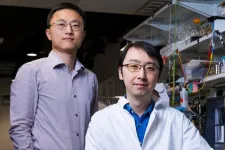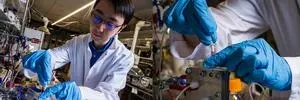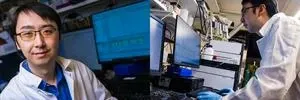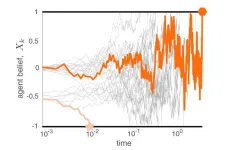(Press-News.org) HOUSTON – (Aug. 12, 2024) – Ammonia plays a critical role in sustaining food production for the world’s growing population, but making it accounts for about 2% of global energy consumption and 1.4% of carbon dioxide emissions. Rice University engineers have developed a revolutionary reactor design that could decarbonize ammonia production while also mitigating water pollution.
In a study published in Nature Catalysis, a team of Rice engineers led by Haotian Wang described the development of a new reactor system that converts nitrates — common pollutants found in industrial wastewater and agricultural runoff — into ammonia, a vital chemical used not only in fertilizers, but also in a wide range of industrial and commercial products, from household cleaners to plastics, explosives and even fuel.
Currently, ammonia is one of the most widely produced chemicals in the world, with global demand surpassing 180 million tons annually. The main way to make ammonia is the Haber-Bosh process, which entails a reaction between hydrogen and nitrogen that occurs under high temperature and pressure conditions and is dependent on large-scale centralized infrastructure. One alternative to this process is electrochemical synthesis, which involves the use of electricity to drive chemical reactions.
“Electrochemistry can occur at room temperature, is more amenable to scalable formats for different infrastructure systems, and has the capacity to be powered by decentralized renewable energy,” said Feng-Yang Chen, a Rice graduate student who is the lead author on the study. “However, the current challenge for this technology is that large quantities of additive chemicals are required during the electrochemical conversion process. The reactor we developed uses recyclable ions and a three-chamber system to improve the reaction’s efficiency.”
One of the key innovations lies in the use of a porous solid electrolyte, which eliminates the need for high concentrations of supporting electrolytes — an issue that has hampered previous attempts to convert nitrates to ammonia sustainably. Moreover, powering the conversion process with renewable energy would essentially render ammonia production carbon neutral.
“We conducted experiments where we flowed nitrate-contaminated water through this reactor and measured the amount of ammonia produced and the purity of the treated water,” said Chen, who is pursuing a doctoral degree in chemical and biomolecular engineering under Wang’s supervision. “We discovered that our novel reactor system could turn nitrate-contaminated water into pure ammonia and clean water very efficiently, without the need for extra chemicals. In simple terms, you put wastewater in, and you get pure ammonia and purified water out.”
The new reactor system makes possible an electrochemical nitrate-to-ammonia conversion pathway that would eliminate the need for denitrification ⎯ the process by which wastewater treatment plants remove nitrates from contaminated water, generating nitrogen that gets fed into the Haber-Bosch process. In addition to bypassing both the traditional denitrification and Haber-Bosch routes, this approach provides an effective water decontamination method.
“Nitrate is one of the priority pollutants that most frequently violates drinking water standards, and it is a is a significant concern in growing cities as farmland with nitrate-contaminated groundwater supplies is converted to urban development,” said Pedro Alvarez, the George R. Brown Professor of Civil and Environmental Engineering, director of the Nanosystems Engineering Research Center for Nanotechnology-Enabled Water Treatment (NEWT) and the Water Technologies Entrepreneurship and Research (WaTER) Institute at Rice.
According to Alvarez, “conventional nitrate removal in drinking water treatment involves ion exchange or membrane filtration by reverse osmosis, which generates brines and transfers the nitrate problem from one phase to another.”
“Professor Wang’s innovation is very timely and important, as it offers a solution that eliminates nitrate toxicity and associated liability without the need to add treatment chemicals,” Alvarez said.
The implications of this work extend beyond ammonia production. The design of the reactor and the study’s accompanying techno-economic assessment can help inform further research into other eco-friendly chemical processes, potentially transforming how industries address environmental challenges.
“Our findings suggest a new, greener method of addressing both water pollution and ammonia production, which could influence how industries and communities handle these challenges,” said Wang, associate professor of chemical and biomolecular engineering, materials science and nanoengineering, and chemistry at Rice. “If we want to decarbonize the grid and reach net-zero goals by 2050, there is an urgent need to develop alternative ways to produce ammonia sustainably.”
The research was supported by Rice University and the National Science Foundation through NEWT (1449500). The content in this press release is solely the responsibility of the authors and does not necessarily represent the official views of the supporting entities.
-30-
This news release can be found online at news.rice.edu.
Follow Rice News and Media Relations via Twitter @RiceUNews.
Click here to read the online press release.
Download associated media files.
Peer-reviewed paper:
“Electrochemical nitrate reduction to ammonia with cation shuttling in a solid electrolyte reactor” | Nature Catalysis | DOI: 10.1038/s41929-024-01200-w
Authors: Feng-Yang Chen, Ahmad Elgazzar, Stephanie Pecaut, Chang Qiu, Yuge Feng, Sushanth Ashokkumar, Zhou Yu, Chase Sellers, Shaoyun Hao, Peng Zhu and Haotian Wang
About Rice:
Located on a 300-acre forested campus in Houston, Rice University is consistently ranked among the nation’s top 20 universities by U.S. News & World Report. Rice has highly respected schools of architecture, business, continuing studies, engineering, humanities, music, natural sciences and social sciences and is home to the Baker Institute for Public Policy. With 4,574 undergraduates and 3,982 graduate students, Rice’s undergraduate student-to-faculty ratio is just under 6-to-1. Its residential college system builds close-knit communities and lifelong friendships, just one reason why Rice is ranked No. 1 for lots of race/class interaction, No. 2 for best-run colleges and No. 12 for quality of life by the Princeton Review. Rice is also rated as a best value among private universities by Kiplinger’s Personal Finance.
END
Rice-built reactor yields green ammonia and purified water
New reactor system could decarbonize ammonia production, treat nitrate-contaminated water
2024-08-13
ELSE PRESS RELEASES FROM THIS DATE:
Think fast — or not: FSU research describes mathematics behind decision making
2024-08-13
New research from a Florida State University professor and colleagues explains the mathematics behind how initial predispositions and additional information affect decision making.
The research team’s findings show that when decision makers quickly come to a conclusion, the decision is more influenced by their initial bias, or a tendency to err on the side of one of the choices presented. If decision makers wait to gather more information, the slower decision will be less biased. The work was published today in Physical Review E.
“The basic result might ...
Largest study of its kind finds common lab tests aren’t reliable for diagnosing Long COVID
2024-08-13
A new study found that most routine laboratory tests are not reliable for diagnosing Long COVID, also known as Post-Acute Sequelae of SARS-CoV-2 infection (PASC).
The study, published today in Annals of Internal Medicine, found no reliable biomarker among 25 routine clinical laboratory values for prior infection, PASC or specific types of PASC clusters. This suggests none of these routine labs can serve as a clinically useful biomarker of PASC.
"Our study shows patients can have severe Long COVID with normal lab results. This ...
Engineers make tunable, shape-changing metamaterial inspired by vintage toys
2024-08-12
Common push puppet toys in the shapes of animals and popular figures can move or collapse with the push of a button at the bottom of the toys’ base. Now, a team of UCLA engineers has created a new class of tunable dynamic material that mimics the inner workings of push puppets, with applications for soft robotics, reconfigurable architectures and space engineering.
Inside a push puppet, there are connecting cords that, when pulled taught, will make the toy stand stiff. But by loosening these cords, the “limbs” of the toy will go limp. Using the same cord tension-based principle that controls a puppet, researchers have developed a new type of metamaterial, a material ...
Start-up Whisper Aero uses the ORNL Summit supercomputer to test concepts for an ultraquiet electric airplane
2024-08-12
From a nondescript industrial building in the small town of Crossville, Tennessee, the team of engineers at Whisper Aero is planning a revolution in aviation technology.
Previously home to a publisher of magazines — including, coincidentally, Trade-A-Plane, an airplane sales publication started in 1937 — the long-empty property’s cavernous spaces are now filled with multidisciplinary activities that include the creation of a new electric aircraft engine.
In January 2024, employees of the 3-year-old start-up moved into their new headquarters, refurbishing its dusty rooms into a 21st century aerospace technology facility with areas ...
New study unveils 16,000 years of climate history in the tropical Andes
2024-08-12
PROVIDENCE, R.I. [Brown University] — A new study that explores ancient temperatures and rainfall patterns in the tropical Andes of South America has revealed how 16,000 years of climate history in this part of the world was driven by carbon dioxide levels and ocean currents from global climate events.
Led by Brown University researchers, the study marks the first high-resolution temperature record covering the past 16,000 years in the tropical Andes and could help scientists predict and mitigate future climate impacts in tropical regions of the planet. The work is described in the Proceedings of the National Academy of Science.
“Usually ...
The Society of Huntsman Translational Scholars welcomes two more members
2024-08-12
Huntsman Cancer Institute and the University of Utah (the U) are proud to announce the induction of two physician-scientists, Heloisa Soares, MD, PhD, and Skyler Johnson, MD, as members of The Society of Huntsman Translational Scholars.
The Society of Huntsman Translational Scholars supports scientists who focus on translating research discoveries made in the lab into innovations that improve outcomes for cancer patients. Scholars receive financial support for their scientific work, have opportunities for mentorship, and collaborate with other society members in advancing scientific discoveries.
“The Society of Huntsman Translational Scholars ...
UMass Amherst researchers create new method for orchestrating successful collaboration among robots
2024-08-12
AMHERST, Mass. – New research from the University of Massachusetts Amherst shows that programming robots to create their own teams and voluntarily wait for their teammates results in faster task completion, with the potential to improve manufacturing, agriculture and warehouse automation. This research was recognized as a finalist for Best Paper Award on Multi-Robot Systems at the IEEE International Conference on Robotics and Automation 2024.
“There’s a long history of debate on whether we want to build a single, powerful humanoid robot that can do all ...
Co-mentors announced in unique opportunity for PCCM fellows
2024-08-12
Glenview, Illinois – For the second year of the APCCMPD and CHEST Medical Educator Scholar Diversity Fellowship, Tristan Huie, MD, FCCP, and Anna Neumeier, MD, will be co-mentors for 2025.
Designed to pair a fellow-in-training with an established medical educator, the unique scholarship was launched in August 2023 by the American College of Chest Physicians (CHEST) and the Association of Pulmonary and Critical Care Medicine Program Directors (APCCMPD) to improve diversity in respiratory care.
The program focuses on creating opportunities for fellows at institutions ...
AI poses no existential threat to humanity – new study finds
2024-08-12
ChatGPT and other large language models (LLMs) cannot learn independently or acquire new skills, meaning they pose no existential threat to humanity, according to new research from the University of Bath and the Technical University of Darmstadt in Germany.
The study, published today as part of the proceedings of the 62nd Annual Meeting of the Association for Computational Linguistics (ACL 2024) – the premier international conference in natural language processing – reveals that LLMs have a superficial ability to follow instructions and excel at proficiency in language, ...
Routine lab tests are not a reliable way to diagnose long COVID
2024-08-12
A National Institutes of Health (NIH)-supported study has found that routine lab tests may not be useful in making a long COVID diagnosis for people who have symptoms of the condition. The study, part of NIH’s Researching COVID to Enhance Recovery (NIH RECOVER) Initiative and published in the Annals of Internal Medicine, highlights how challenging it can be to identify and diagnose a novel illness such as long COVID.
“Our challenge is to discover biomarkers that can help us quickly and accurately diagnose long ...
LAST 30 PRESS RELEASES:
Making lighter work of calculating fluid and heat flow
Normalizing blood sugar can halve heart attack risk
Lowering blood sugar cuts heart attack risk in people with prediabetes
Study links genetic variants to risk of blinding eye disease in premature infants
Non-opioid ‘pain sponge’ therapy halts cartilage degeneration and relieves chronic pain
AI can pick up cultural values by mimicking how kids learn
China’s ecological redlines offer fast track to 30 x 30 global conservation goal
Invisible indoor threats: emerging household contaminants and their growing risks to human health
Adding antibody treatment to chemo boosts outcomes for children with rare cancer
Germline pathogenic variants among women without a history of breast cancer
Tanning beds triple melanoma risk, potentially causing broad DNA damage
Unique bond identified as key to viral infection speed
Indoor tanning makes youthful skin much older on a genetic level
Mouse model sheds new light on the causes and potential solutions to human GI problems linked to muscular dystrophy
The Journal of Nuclear Medicine ahead-of-print tip sheet: December 12, 2025
Smarter tools for peering into the microscopic world
Applications open for funding to conduct research in the Kinsey Institute archives
Global measure underestimates the severity of food insecurity
Child survivors of critical illness are missing out on timely follow up care
Risk-based vs annual breast cancer screening / the WISDOM randomized clinical trial
University of Toronto launches Electric Vehicle Innovation Ontario to accelerate advanced EV technologies and build Canada’s innovation advantage
Early relapse predicts poor outcomes in aggressive blood cancer
American College of Lifestyle Medicine applauds two CMS models aligned with lifestyle medicine practice and reimbursement
Clinical trial finds cannabis use not a barrier to quitting nicotine vaping
Supplemental nutrition assistance program policies and food insecurity
Switching immune cells to “night mode” could limit damage after a heart attack, study suggests
URI-based Global RIghts Project report spotlights continued troubling trends in worldwide inhumane treatment
Neutrophils are less aggressive at night, explaining why nighttime heart attacks cause less damage than daytime events
Menopausal hormone therapy may not pose breast cancer risk for women with BRCA mutations
Mobile health tool may improve quality of life for adolescent and young adult breast cancer survivors
[Press-News.org] Rice-built reactor yields green ammonia and purified waterNew reactor system could decarbonize ammonia production, treat nitrate-contaminated water






